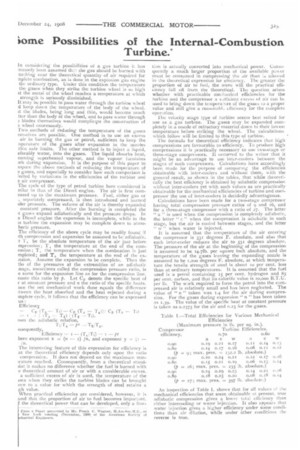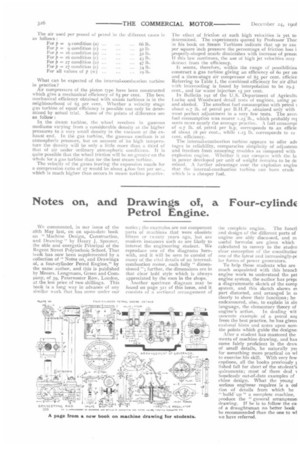6ome Possibilities of the Internal-Combustion Turbine.*
Page 15

Page 16

If you've noticed an error in this article please click here to report it so we can fix it.
In considering the possibilities of a gas turbine it has Tin/only been assumed the' the gas should be burned with nething, near the theoretical quantity of air required for aiplete combustion, as is done in the explosion gas engine the ordinary type. Under this condition the temperature the gases when they strike the turbine wheel is so high it the metal of the wheel reaches a temperature at which strength is seriously diminished.
It may be possible to pass water through the turbine wheel d keep down the temperature of the body of the wheel. it the blades, being long and thin, would become much toe' than the body of the wheel, and to pass water through e blades themselves would complicate the construction of e wheel enormously.
'Iwo methods of reducing the temperature of the gases emselves are possible. One method is to use an excess air in burning the gas or petrol, sufficient to keep the
nperature of the gases after expansion in the nozzles thin safe limits. The other method is to inject a liquid, eferably water, into the gases. The liquid absorbs heat, coming superheated vapour, and the vapour furnishes srk during expansion. It is the purpose of this paper to tnpare the above methods of reducing the temperature of e gases, and especially to consider how such comparison is ected by variations in the efficiencies of the turbine and C air compressor.
The cycle of the type of petrol turbine here considered is nilar to that of the Diesel engine. The air is first cornessed up to the maximum pressure. Fuel, either gas or ., separately compressed, is then introduced and burned ider pressure. The volume of the air is thereby expanded
constant pressure. After the burning is completed the it gases expand adiabatically and the pressure drops. In
e Diesel engine the expansion is incomplete, while in the is turbine the expansion may be complete down to annoheric pressure.
The efficiency of the above cycle may be readily found if eh compression and expansion be assumed to be adiabatic. :t T., be the absolute temperature of the air just before mpression ; T, the temperature at the end of the camession • Ts the temperature when the combustion is just mpleterl; and T3 the temperature at the end of the exstsion. Assume the expansion to be complete. Then the tio of the pressures at the extremities of an adiabatic .ange, sometimes called the compression pressure ratio, is e same for the expansion line as for the compression line. enote this ratio by p. Let CT, denote the specific heat of r at constant pressure and n the ratio of the specific heats. nce the net mechanical work done equals the difference ;tssreen the heat absorbed and the heat rejected during a mplete cycle, it follows that the efficiency can be expressed us ;
Efficiency
Cp (IT TO Cp (T3 Cp (Ts -Te sss 1Ta T4) / 1T5 rom the adiabatic relation, Tirrs== pxersiTs, ,nsequently, Efficiency (T4IT1) 16Y
here exponent x = (n fn, and exponent y in.
The interesting feature of this expression for efficiency is at the theoretical efficiency depends only upon the ratio compression. It does not depend on the maximum tern nature reached. Consequently, from a theoretical stand>int it makes no difference whether the fuel is burned with e theoretical amount of air or with a considerable excess.
a sufficient excess oF air is used, the temperature of the ises when they strike the turbine blades can be brought evn to a value for which the strength of steel retains a g-h value.
When practical efficiencies are considered, however, it is und that the proportion of air to fuel becomes important.
f the theoretical power that can be developed, only a frac-
F.M111 a Paper pres(mted by Mr_ 'Prank C. Wagner. M.Ain.F4oe.M.E., at New York meeting (December, 1908) of the American Society of clianical Engineers,
Lon is actually converted into mechanical power. Consequently 4. much larger proportion of the available power must be consumed in compressing the air than is allowed in the theoretical expression for einciency. The greater the proportion of air to fuel, the more will the practical efficiency fall off from the theoretical. The question arises whether with practicable meehanical efficiencies for the turbine and the compressor a ssiticient excess of air can be used to bring down the tempera atre of the gases to a proper value and still give a reasonabls efficiency for the complete opera tion.
The velocity stage type of turbine seems best suited for use as a gas turbine. The gases may be expanded completely in a nozzle of refractory material down to their lowest temperature before striking the wheel. The calculations which follow will be limited to this type of turbine. The formula for theoretical efficiency indicates that high compressions are favourable to efficiency. To produce high compressions it is practically necessary to use two-stage or three-stage compressors. It occurred to the wrifer that it might be an advantage to use inter-coolers between the stages of such compressors. Calculations have accordingly been made for the purpose of cumparMg the efficiencies obtainable with inter-coolers and without them, with the general tesult, as shown in the tables, that while theoretically the best efficiency is obtained by adiabatic compression without inter-coolers yet with such values as are practically obtainable for the mechanical efficiencies of turbine and compressor the use of inter-coolers is decidedly advantageous.
Calculations have been made for a two-stage compressor having total compression pressure ratios of 9 and 16, and for a three-stage compressor with a ratio of 27. The letter " a " is used when the compression is completely adiabatic, the letter " c " when the compression is adiabatic in each stage, but the air is cooled between stages, and the letter " w " when water is injected. It is assumed that the temperature of the air entering the compressor is 531 degrees F. absolute, and also that each inter-cooler reduces the air to 531 degrees absolute. The pressure of the air at the beginning of the compression is assumed to be 4.71b. per square inch absolute, and the temperature of the gases leaving the expanding nozzle is assumed to be 1,2oo degrees F. absolute, at which temperature the tensile strength of steel is about 10 per cent. less than at ordinary temperatures. It is assumed that the fuel used is a petrol containing 15 per cent, hydrogen and 83 per cent, carbon, and that its csilorilic value is 20,000 B.T.U. per lb. The werk required to force the petrol into the compressed air is relatively small and has been neglected. The value of " n " taken was 1.4 for the air during compression. For the gases during expansion " n " has been taken as 1.39. The value of the specific heat at constant pressure is taken as 0.2375 for the air and 0.25 for the gases.
Table I.-Total Efficiencies for Various Mechanical Efficiencies (Maximum pressure in lb. per sq. in.). Compressor Turbine Efficienc.ics.
0
efficiency. .70 o.6o a C W a
0.90 0.19 0.21 0.17 0.11 0.14 0.13
o.80 0.14 0.17 0.16 n.n6 0.11 0.12 (p = 9; max. pres. = 132.2 lb. absolute.)
0.90 cseo 0.24 0.21 0.12 0.17 0.16
o.8so 0.15 0.21 0.19
0.06 0.13 0.14
(p = 161 max. ores. se235 lb. absolute.)
0.90 0.24 0.29 0.23 0.14 0.21 C.16 o.80 °A 0.25 0.20 0.08 0.18 0.14 (p = 27; max. pres. = 397 lb. absolute.)
An inspection of Table I. shows that for all values el the mechanical efficiencies that seem obtainable et present, true adiabatic compression gives a lower total efficiency than either intercoolingor water injection. It also appears that water injection gives a higher efficiency under some conditions than air dilution, while under other conditions the reverse is true.
What can be expected of the internal-combustion turbine in practice? Air compressors of the piston type have been constructed which give a mechanical efficiency of 85 per cent. The best mechanical efficiency obtained with steam turbines is in the neighbourhood of 65 per cent. Whether a velocity stage gas turbine of equal efficiency is possible can only be determined by actual trial. Some of the points of difference are as follow : In the gteam turbine, the wheel revolves in gaseous mediums varying from a considerable density at the higher pressures to a very small density in the vacuum at the exhaust end. In the gas turbine, the gaseous medium is at atmospheric pressure, but on account of its high temperature the density will be only a little more than a third of that of air under ordinary atmospheric conditions. It is quite possible that the wheel friction will be no greater on the whole for a gas turbine than for the best steam t hi tur__.ne. The velocity of the gases leaving the expansion nozzle for a compression ratio of 27 would be about 4 feet ..00 , .ce_ per sec., which is much higher than occurs in steam turbine practice.
The effect of friction at such high velocities is yet to determined. The experiments quoted by Professor Thor in his book on Steam Turbines indicate that up to 220 per square inch pressure the percentage of friction loss i properly-shaped nozzle diminishes with increase of press'. If this law continues, the use of high jet velocities may detract from the efficiency.
It seems, therefore, within the range of possibilities construct a gas turbine giving an efficiency of 6o per cei and a three-stage air compressor of 85 per cent. efficien Referring to Table I, the combined efficiency for air dilut with intercooling is found by interpolation to be 19.5 cent., and for water injection es per cent. In Bulletin 191 of the U.S. Department of Agricultt I,ucke and Woodward detail tests of engines, using pc and alcohol. The smallest fuel consumption with petrol about 0.7 lb. of petrol per B.H.P., obtained only with most perfect adjustment in a very few tests. The aver; fuel consumption was nearer 1.25 lb., which probably re/ sents more nearly the average practice. A fuel consumpt of o.7 lb. of, petrol per h.p, corresponds to an efficie of about 18 per cent., while 1.25 lb. corresponds to to cent. efficiency.
The internal-combustion turbine appears to offer adv tagcs in reliability, comparative simplicity of adjustmei and freedom from annoying troubles as compared with explosion engine. Whether it can compLte with the la in power developed per unit of weight remains to be de mined. A further advantage over the explosion engin( that the internal-combustion turbine can burn crude which is a cheaper fuel.




















